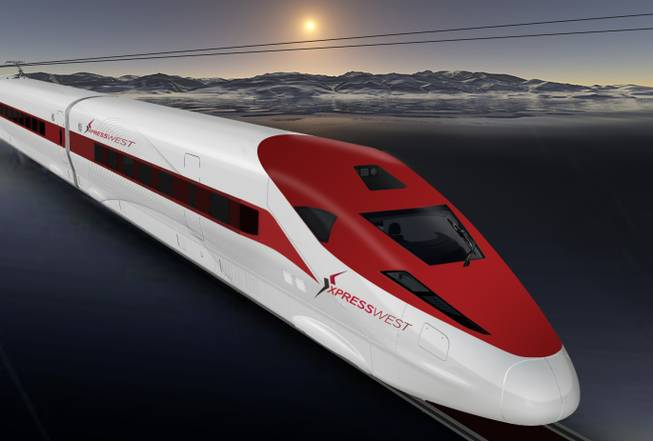
Courtesy of XpressWest
An artist’s rendering of a train on the XpressWest high-speed rail line.
Wednesday, Oct. 25, 2017 | 2 a.m.
Related Coverage
High-speed rail transportation between Southern California and Las Vegas so far has been a highly sought yet unattainable goal for Nevada’s resort industry.
If constructed someday, it would provide a safe, quick and economical way for Las Vegas to tap into one of its biggest tourism markets and an established fan base for Raiders football.
That “someday” may be coming soon, says Sig Rogich, president of the Rogich Communications Group, a Las Vegas-based public relations and crisis management firm.
When “Nevada Newsmakers” host Sam Shad asked Rogich last week if it could take 30 years to get high-speed rail service going for Las Vegas, Rogich countered:
“No, I don't think 30 years at all. I think it is probably five to eight years from now. You are going to see this new industry of high-speed rail start to develop,” Rogich said.
A high-speed connection from Palmdale, Calif., to Las Vegas could jump-start the high-speed rail industry in the U.S., which could be “transformational” to the Western U.S., Rogich said.
“Once that happens (Palmdale to Las Vegas high-speed service) — and it will eventually — you are going to see high-speed rail from Phoenix,” Rogich said. “It's a direct shot to Palmdale, from Salt Lake City into Phoenix and then Salt Lake City to here (Las Vegas).”
A Catch-22 federal regulation has made high-speed rail unattainable. High-speed rail trains that operate in the U.S. must be manufactured in the U.S. to get any federal funding, according to the regulation. However, there is no high-speed train production currently in the U.S.
In 2015, XpressWest announced a deal with China Railway International to build the high-speed rail from Los Angeles to Las Vegas. Nine months later, the deal was off. In a prepared statement, XpressWest was critical of the federal regulation.
“As everyone knows, there are no high-speed trains manufactured in the United States,” XpressWest’s statement on June 8, 2016, said. “This inflexible requirement has been a fundamental barrier to financing high-speed rail in our country.
“For the past 10 years, we have patiently waited for policymakers to recognize high-speed rail in the United States as a new enterprise and that allowing trains from countries with decades of safe high-speed rail experience is needed to connect the Southwest region and start this new industry,” XpressWest wrote.
President Donald Trump’s stated desire for improved infrastructure may eliminate that roadblock, Rogich says, and the regulation that all high-speed trains must be built in the United States “is not a firm rule.”
“The (Obama administration) thought that they had to have everything manufactured in the United States,” he said. "But no one (in the U.S.) was building it. They didn't want China to build it."
It’s possible a foreign government could build the train project on its own, Rogich says.
“You may find that whoever comes aboard might build it themselves,” he said. "Private (companies), maybe other governments. China is a natural, so is Japan.”
Surpassing Switzerland and Germany, China has become the world’s best high-speed train builder, said Rogich, whose firm works with China.
China has the most-extensive high-speed rail system in the world, with about 12,000 miles of track, according to the Los Angeles Times. China is trying to export its train technology to other nations, including Mexico and the Southeast Asia region.
“China's got the rolling stock over there, ready to go,” Rogich said. "They can build it cheaper, faster and better. … They are building the next wave of trains that will travel at 350 mph, and their goal is 500 mph.”
Rogich says he’s ridden on trains in China several times. “They are extraordinary,” he said. “Every seat is like a first-class seat. You can stretch out, lay out, go to sleep and have great services at your disposal. It is a whole new industry, and I think you are going to see it a lot.”
A high-speed train to Las Vegas would divert an estimated 25 percent of the traffic now coming into Las Vegas on Interstate 15, according to an XpressWest study.
“There is no place to build and add onto freeways,” Rogich said. “Keep in mind the big thing, too. If we are trying to cut down on emissions, you put a train in play that is all electric. It eliminates dozens of new lanes of highway that would otherwise come into play. And that means tens of millions of cars would stay off the road because they are taking the high-speed trains.”
Ray Hagar is a retired political journalist from the Reno Gazette-Journal and current reporter/columnist for the Nevada Newsmakers podcast and website, nevadanewsmakers.com. Follow Ray on Twitter at @RayHagarNV.

Join the Discussion:
Check this out for a full explanation of our conversion to the LiveFyre commenting system and instructions on how to sign up for an account.
Full comments policy